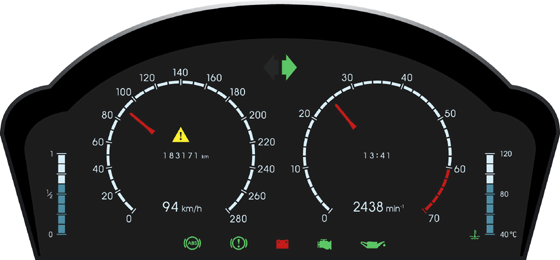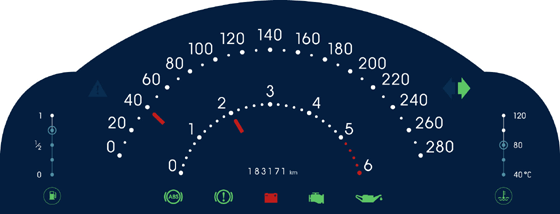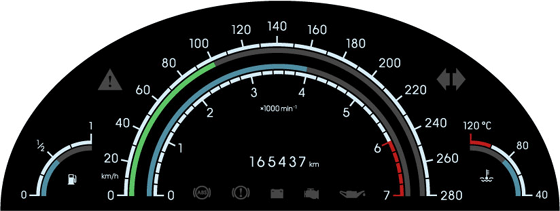Article 23
Automotive digital LCD dashboards

1. Introduction
In the past automobile meant mechanics. Then mechanics and electrics. And today it means mechanics and electronics. Modern car is sophisticated unity of
high-accuracy mechanics and high-end electronics. Today microprocessors, those creatures of science world, are everywhere. They are small in size, reliable in
functioning, effective in controlling various parameters. No wonder they have found their proper place in car-building industry, where control of parameters of any
kind is in high demand.
 Fig. 1. Automotive digital LCD dashboard graphical design. Classical version.
Fig. 1. Automotive digital LCD dashboard graphical design. Classical version.
Modern automotive microprocessors are highly integrated hybrid systems, that contain central processing unit — CPU, — graphic processing unit —
GPU, — and additional peripherals for interacting with other chips and units, like CAN, I2C and UART interfaces — that is why they called
systems on chip — SoC.
 Fig. 2. Automotive digital LCD dashboard graphical design. Mini-car version.
Fig. 2. Automotive digital LCD dashboard graphical design. Mini-car version.
Maybe the first thought, the first picture when mentioning car is wheel and dashboard. Everybody who likes cars and driving loves that environment —
well-shaped wheel, curved lines of torpedo, rows of gauges, switches and buttons. In collaboration with talented designer Michail Mukovoz Librow developed this
marvelous product — digital LCD dashboard.
 Fig. 3. Automotive digital LCD dashboard graphical design. Sport version.
Fig. 3. Automotive digital LCD dashboard graphical design. Sport version.
2. Digital LCD dashboard
The objective we persuaded in this project was to create compact, reliable and effective solution for digital car dashboard. Virtual instrument cluster development includes
four major fields:
hardware,
housing,
firmware and
graphical design.
Video 1. Automotive digital instrument cluster prototype.
Hardware includes components selection and PCB — printed circuit board — design. For this case we have selected Fujitsu SoC automotive processor, which has
impressive characteristics: it has both 2D and 3D graphics engines, capable to render multilayered frames of up to 1024×768 pixels size, power effective
ARM CPU core with excellent performance and a bunch of interfaces for in-car integration.
Graphical design — virtual gauges drawings, their placing and graphical interface — was created by Michail Mukovoz.
The most important part of the firmware — graphics rendering pipeline — was developed using techniques of computer graphics and digital image processing —
DIP. Most of the code was written in C. Combination of the chip performance and thorough programming gave an impressive result — the whole dashboard with
every indicator in action could be rendered just in frame blank period at 60 Hz. That is even single buffering rendering is enough for smooth and antialiased
animation.
As result we got integrated closed solution that could be easily modified for any graphical design and adapted for any embedded platform.
The entire digital dashboard solution consist of SoC processor, flash and dynamic memory, touch-screen, LCD unit and embedded firmware, which includes graphics
rendering pipeline, interface system and graphical design.
3. Available options
Development and manufacturing of automotive
digital instrument clusters:

|
- creation of the instrument cluster graphics from scratch
- development of the dashboard graphics based on your specification
- redesign of the existing graphics
- moving real metal and plastic design into virtual realm
|

|
- schematics
- component selection
- PCB design, prototyping and manufacturing
- integration of the instrument cluster with other on-board systems
- service and support of the manufactured instrument clusters
|

|
- 2D and 3D graphics
- GUI
- peripheral drivers
- communication protocols
- RTOS
|

|
- design
- material selection
- 3D rendering
- prototyping and manufacturing
|
|

 Fig. 1. Automotive digital LCD dashboard graphical design. Classical version.
Fig. 1. Automotive digital LCD dashboard graphical design. Classical version.
 Fig. 2. Automotive digital LCD dashboard graphical design. Mini-car version.
Fig. 2. Automotive digital LCD dashboard graphical design. Mini-car version.
 Fig. 3. Automotive digital LCD dashboard graphical design. Sport version.
Fig. 3. Automotive digital LCD dashboard graphical design. Sport version.






